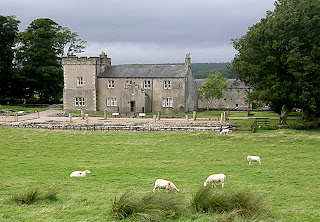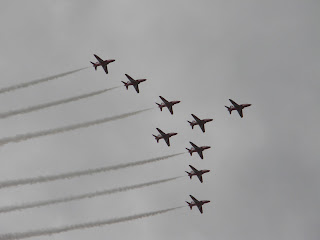Our final visit on the second day was to Chesters which was by far the most attractive of the sites we saw - it also sells fabulous ice cream:) The setting is really lovely and it was helped by a blue sky and warm sunshine.
The river is the North Tyne.
This will be a long photo heavy post but this is because my blog acts as a kind of diary for me rather than because I think that everyone is so desperately interested. In fact I can already hear cries of 'oh no, not more Roman ruins!' :):) Many of these photos will be clearer if you click on them to enlarge them.
The preservation is pretty good at Chesters, this is part of the Barracks. For most of its time Chesters was home to the 500 men of the Second Cavalry Regiment of Asturians from Spain. The barracks would have had stabling for the horses as well as accommodation for the men - eight men to a room with separate houses for the officers.
This is the Commanding Officer's House which has its own private Bath House - the difference between the COs living quarters and those of the men was substantial!
The Bath House at Chesters is one of the best preserved buildings of Roman Britain. Itwas an important part of the fort, the Romans were aware that where so many men were housed at close quarters hygiene was an important consideration. The Bath House was also a place which acted as a social centre. The men not only went there to get clean (by being covered in oil which was then scraped off with a strigil) but they could also recline on the stone benches in the various rooms chatting or playing board games. My shadow was an unavoidable part of the photo due to the late afternoon sun:)
The Hot Bath - there were several rooms of varying temperatures from cold to really hot and usually a plunge pool too.
The final photo from Chesters shows the Strong Room at the back of the Headquarters Building
Not far from Chesters at Carrawburgh is the Temple of Mithras. The Eastern cult of Mithraism was a very popular one with Roman soldiers. It's interesting as well, more about it if you follow
this link.
A close up of the three altars (replicas, the originals are in the Museum of Antiquities at Newcastle)which stand at the far end of the temple. The altar on the left shows Mithras as Charioteer of the Sun. The carving is done in such a way that a lamp placed in the hollow behind Mithras will cause the rays to light up. As a matter of fact the way the sunlight is falling on it gives you an idea of the effect the lighted lamp would have.
The annoying thing about this stop is that I didn't discover until too late is that just a little way further on is Coventina's Well. I'm researching the gods and goddesses of the Brigantes tribe and Coventina is one of these. I believe there's little there now other than the spring but just the same I would have loved to have seen it.

The final morning was spent at Vindolanda which is famous for the wood tablets that give a wonderful insight into daily life in this fort on the northern frontier of the Roman Empire. There are work assignments, lists of stores, a letter (probably from the soldier's Mum!) saying ' I have sent you ...pairs of socks from Sattua, two pairs of sandals and two pairs of underpants' :) Another one is to Sulpicia Lepidina, the wife of the fort's commanding officer, from Claudia Severa, the wife of the CO of a neighbouring fort,inviting Sulpicia to a birthday party. All of which has nothing whatever to do with the photo above which is a reconstruction of one of the timber milecastle gateways on Hadrian's Wall.
Vindolanda had excellent water supplies from wells and water tanks fed by springs and streams. Above is a stone slab water tank, the water was channeled to the fort and civilian buildings in stone aqueducts or timber pipes.
This is the remains of a mausoleum, one of several outside the gates of the fort. The Romans didn't allow burials within the boundaries of their forts or towns and the roads leading to them were often lined with tombs and mausoleums
Outside every Roman fort there grew up a civilian population eager to part the soldiers from their hard earned money. Many of the soldiers had families living in the vicus too although they weren't allowed to marry while they were serving soldiers. The vicus contained shops of all descriptions, pubs, both craft and industrial workshops and domestic housing. This is the road leading from the vicus through the West gate into the fort.
This was probably a butchers shop with drainage channels in the floor.
Inside the fort itself this is what remains of the Military Bath House, the artist's impression below shows how it would have looked originally. The steps on the right of the first photo are clearly visible and the pillars to the left would have supported the floor of the hot dry room and the cold room with the changing rooms to the left of that. If you enlarge the photos it will be clearer:) Note the latrine at the front of the artist's impression - the Romans were a very sociable lot!


The fort contained the usual Principia (HQ building), Praetorium (C/Os house), Horrea(granaries) and Barracks. The photo shows part of the private bath house in the commanding officer's residence. You can see the pilae of the hypocaust system that was used to heat not only bath houses but homes as well. Hot air from a furnace circulated under the floor that was built on top of the pilae. Spaces were left inside the walls so that the hot air and smoke could escape through flues in the roof. Clever chaps these Romans!
I've put in this photo of the Headquarters Building to try and give an idea of the size of it - it really was large and impressive.
This is on the top right of the above photo near the little tiny people, it's the strong room behind the central shrine.
This is one of the fort latrines - you have to imagine a row of wooden benches along three sides with about 16 hinged seats:) You can see the two channels down the central floor too which would contain running water for washing sponges. I leave the rest to your imagination!
These hut circles date from about AD208-211 when the Emperor Septimius Severus was campaigning against the northern tribes in Scotland. No-one really knows who they housed - possibly hostages or refugees from friendly tribes looking for protection from the warfare in the north. The earlier Severan fort lay further to the east of the current fort wall
Vindolanda is still being excavated and every summer volunteer diggers come from not only all parts of Britain but from all over the world to help with this vast project. There's a great deal still to be discovered here. There is also an excellent Museum which houses many of the finds including the writing tablets. After a spot of lunch in the cafe(also very good) I set off on the long drive home - the sort I hate, nearly all motorway which is both busy and boring. Worth it for the wonderful experience of walking the Wall though.



















































